This is the first installment of a brand new section called "Inside an America's Cup team" where we will try to give an in-depth perspective of the various departments that comprise an America's Cup team.All America's Cup teams in Valencia have at least one meteorologist working full time on weather observation and forecast. Why is it so important for the teams to have a dedicated weather department? What part does weather forecast play in the success of a team? We talked to
Guenter Meschkat, meteorologist of Team Shosholoza, who gave us a detailed overview of his daily job in Valencia.
Basic overview of the weather in Valencia
The most important meteorological phenomenon in Valencia affecting sailing in general and the America's Cup in particular is the
sea breeze, especially in the critical months from April to July since the Louis Vuitton Cup and the America's Cup take place during these months in 2007. In meteorology the sea breeze is a local wind created by temperature differential between land and sea. According to Guenter Meschkat no other larger scale atmospheric conditions affect Valencia's weather in such a significant way, at least as far as the America's Cup is concerned during the previously mentioned period.

Here is a basic explanation of how the sea breeze is created (with numbers in brackets refering to the numbers in the graph): At the surface, the sun warms both the ground and ocean at the same rate. However, since the heat in the ground is not absorbed well it returns it to warm the air. The warmed air, with its decreased density, begins to rise (1). The rising air creates a weak low pressure area (called a thermal low) due to a decrease in air mass at the surface (2). Typically, from 3,000 to 5,000 feet (1,000 to 1,500 meters) above this low pressure, as the air cools, it begins to collect resulting in an increase in pressure, creating a "high" (3).
These differences in pressures over land, both at the surface and aloft are greater than the differences in pressures over water at the same elevations (4 and 5). Therefore, as the atmosphere seeks to reestablish equal pressure both onshore and offshore, two high pressure to low pressure airflows develop; the offshore flow aloft (6) and surface onshore flow, called the sea breeze (7).
According to Shosholoza's meteorologist the sea breeze in Valencia follows more or less a pattern, keeping in mind that weather is not an exact science. It starts at around 11am with winds coming from the North East and then at around noon a shift to the right can be observed with winds coming from the East. At early afternoon winds shift further to the right, coming from a direction of 140 degrees from South East. Finally, the sea breeze starts decreasing at around 4pm and dies down 1 or two hours later. This fact can cause problems to races that start at around that time frame.
Correct forecast of sea breeze is the key element in Valencia
Given the primordial role the sea breeze plays over any sailing in Valencia's bay, the key task for any weatherman in the 32nd America's Cup, according to Shosholoza's meteorologist, is to build a model that will simulate it as accurately as possible and correctly predict its development. We will not enter into the details of how these models work but will give the basic outline of their functioning. In brief, a model is a complex set of a large number of mathematical equations that approximate and simulate the real-world atmosphere.
Any model will divide a given area into a grid made up of squares whose size will depend on the required degree of accuracy. After that, the computer program will approximate the weather and simulate its future development, giving a value for each square. Obviously, the smaller the scale (ie the smaller the size of the square) the better the approximation. The
Synoptic scale uses squares whose side is from 15km to 50km and is used in the weather forecasts we read in the newspapers or see on the TV news. The
Mesoscale uses squares whose side can go below 1km and up to 10km and is the one used by all America's Cup teams in order to make their forecast.
Each America's Cup team run their own
numerical mesoscale forecast model. Team Shosholoza uses the
METRAS model, developed by the German University of Hamburg. In addition, two mathematicians from the German University of Karlsruhe work together with the team in order to continuously optimize the computer programs that run the model, making them more accurate and faster. METRAS gives a forecast of air temperature, pressure, humidity as well as wind speed and direction for every square of the grid at 10-minute intervals. In addition, within the same square these values are given for different altitudes, the first one being at 10 meters from sea level, approximately one third of the mast of an America's Cup yacht.
These models are very complex and take into consideration a very large number of factors. The sea breeze depends, among others, on sea and earth temperature, land morphology, the existence of mountains or built-up areas, inland lakes close to the coast or even vegetation! A very good example of that is the lake of Albufera, located 5km south of Valencia and just 200m from the coast. Being adjacent to the South race course and surrounded by a large pine forest it influences the sea breeze considerably, resulting in different patterns between the South and North courses.
A second factor of great importance in the local Valencia weather model is the presence of a mountain range approximately 15km from the coast. These steep mountains, whose peaks reach 1100m, and the corresponding valleys have a great influence over the development of the sea breeze.
Summarizing, although the 32nd America's Cup is taking place on the Mediterranean coast these three elements (mountains, lake and a large metropolitan area) adjacent to the race courses make the construction of the model much more complex.
How teams use weather predictions
How do the America's Cup teams use the predictions produced by their models? In order to be more accurate we will distinguish between a
forecast and a
nowcast. The forecast is a longer-term prediction of up to 30 hours while the nowcast, as its name implies, refers to the current weather situation and its immediate development over the next 30 minutes. Although both contain future predictions their construction and use by an America’s Cup team are quite different.
The
forecast, given its complexity, necessitates a whopping amount of computer power. In order to run its forecast program, Shosholoza uses a cluster of computers made up of 220 Intel Itanium CPUs, located in the T-Systems headquarters in Germany. Despite this seemingly immense computer power, the METRAS program (more than 20,000 lines long) needs to start running at midnight the day before. After running for 8 hours the program will have been able to forecast the weather for the next 4 hours.
As a result, when Shosholoza's weather team geso to the team base in Valencia at 8am to start their workday, they have a complete simulation of the weather at 10-minute intervals till only 12pm! For that reason, not only does the program have to run continuously but they also start a new run, working in parallel with the others, every 3 hours with new real weather data, at 3am, 6am, 9am and so forth!
This forecast is then used in order to establish the day’s activities. When not in official racing, all teams train on a daily basis off Valencia’s coast and as a result their schedule will depend on weather development till approximately 6pm. The the team's mornings briefing takes place at around 10am and that is where the important decisions of the day are taken.
Depending on the weather forecast the team will adapt their training program, choose the right sail sets, decide whether to experiment and test new equipment or even decide where to sail. It is not rare to see the yachts move from one race course to the other in order to take advantage of stronger winds, joining other teams that were already there, with apparently better predictions for that particular day. If at a later stage, around 1pm, the weather department has a refined forecast for the rest of the day, the chase boats can swap sails with the team’s yacht.
The
nowcast takes considerably less time to be built and its use is much different. Unlike the forecast, Shosholoza uses an in-house cluster of computers to run it, right inside the base. It is intended to be used by the crew of the yacht during the pre-start procedure and the first 10 minutes of a race. According to the rules of the America's Cup, the racing yacht can communicate with the rest of the team till 5 minutes before the start of the race and after that moment all communication is strictly prohibited. As a result, the Shosholoza's weather team till exactly that deadline provide the crew with an almost real-time overview of the weather and a continuously developing short forecast for the next 10-15 minutes.
At exactly 5 minutes before the start, in addition to the exact current wind conditions, the crew needs to have two basic information in order to plan their strategy and decide where to go at the start:
wind shift and
wind pressure. In sailor-talk, wind shift means change in wind direction while wind pressure means wind speed. These two factors are of uttermost importance during pre-start and their correct knowledge can make the difference between being the leader or the laggard at the start. The crew needs to know on what side wind speed is greater but also if a shift (change in direction) can be foreseen. Just a change of 3 degrees in wind direction can decide who is ahead at the start line and approximately at 80% of the races the boat having the advantage at the starting line will win the race.
Given this information, the team will make the final decision about the start, whether to go to the right or left side of the race course. Even if pressure (wind speed) is greater on the left side, if the nowcast can foresee a significant shift to the right in the next minutes, the team might as well go to the right side and take advantage of it.
Graphs
 Satellite view of the Valencia area with the mountain range visible at the back (west). The four limit points correspond to the four corners of the official America's Cup racing area.
Satellite view of the Valencia area with the mountain range visible at the back (west). The four limit points correspond to the four corners of the official America's Cup racing area. A synoptic scale weather forecast of central and eastern Spain for 18 September 2006. The arrows represent wind direction while the colored areas correspond to the bottom scale, showing wind speed in knots.
A synoptic scale weather forecast of central and eastern Spain for 18 September 2006. The arrows represent wind direction while the colored areas correspond to the bottom scale, showing wind speed in knots. A mesocale weather forecast of the Valencia region for 18 September 2006. The arrows represent wind direction while the colored areas correspond to the right-hand scale, showing wind speed in knots. The black spots correspond to weather measurement stations and buoys. One can easily observe that the prevailing wind direction around Valencia is from east-southeast while wind speed is greater exactly in the area that corresponds to the official racing area of the 32nd America's Cup. Further to the west and inland, there is a considerable decrease in wind speed due to the aforementioned mountain range surrounding the Valencia region.
A mesocale weather forecast of the Valencia region for 18 September 2006. The arrows represent wind direction while the colored areas correspond to the right-hand scale, showing wind speed in knots. The black spots correspond to weather measurement stations and buoys. One can easily observe that the prevailing wind direction around Valencia is from east-southeast while wind speed is greater exactly in the area that corresponds to the official racing area of the 32nd America's Cup. Further to the west and inland, there is a considerable decrease in wind speed due to the aforementioned mountain range surrounding the Valencia region.
 Team Omega Russell Coutts racing in the Portoroz Cup. Photo copyright Heike Schwab
Team Omega Russell Coutts racing in the Portoroz Cup. Photo copyright Heike Schwab Mascalzone Latino Capitalia Team racing in the Portoroz Cup. Photo copyright Heike Schwab
Mascalzone Latino Capitalia Team racing in the Portoroz Cup. Photo copyright Heike Schwab Close races between Mascalzone Latino Capitalia Team and Team Omega Russell Coutts in the Portoroz Cup. Photo copyright Heike Schwab
Close races between Mascalzone Latino Capitalia Team and Team Omega Russell Coutts in the Portoroz Cup. Photo copyright Heike Schwab Italian duel at the Portoroz Cup with Mascalzone Latino Capitalia Team and Magia Team. Photo copyright Heike Schwab
Italian duel at the Portoroz Cup with Mascalzone Latino Capitalia Team and Magia Team. Photo copyright Heike Schwab Mascalzone Latino Capitalia Team racing at the Portoroz Cup. Photo copyright Heike Schwab
Mascalzone Latino Capitalia Team racing at the Portoroz Cup. Photo copyright Heike Schwab Mascalzone Latino Capitalia Team racing at the Portoroz Cup. Photo copyright Heike Schwab
Mascalzone Latino Capitalia Team racing at the Portoroz Cup. Photo copyright Heike Schwab Mascalzone Latino Capitalia Team racing at the Portoroz Cup. Photo copyright Heike Schwab
Mascalzone Latino Capitalia Team racing at the Portoroz Cup. Photo copyright Heike Schwab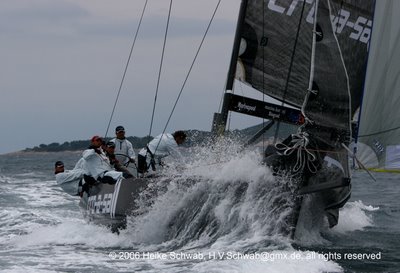 Team Cro-A-Sail fighting the waves in the Biograd regatta. Photo copyright Heike Schwab
Team Cro-A-Sail fighting the waves in the Biograd regatta. Photo copyright Heike Schwab Close Racing in the Biograd Regatta, Team Omega Russell Coutts versus Team Cro-A-Sail. Photo copyright Heike Schwab
Close Racing in the Biograd Regatta, Team Omega Russell Coutts versus Team Cro-A-Sail. Photo copyright Heike Schwab












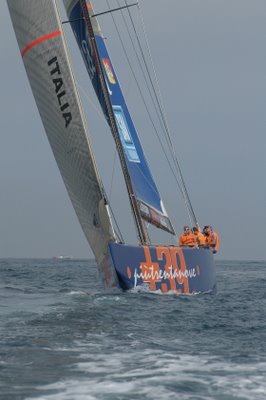










 [Text and Images: Emirates Team New Zealand] Emirates Team New Zealand has launched its second 2007 race yacht, with Prime Minster Helen Clark performing the honours at the team’s Auckland base.
[Text and Images: Emirates Team New Zealand] Emirates Team New Zealand has launched its second 2007 race yacht, with Prime Minster Helen Clark performing the honours at the team’s Auckland base.
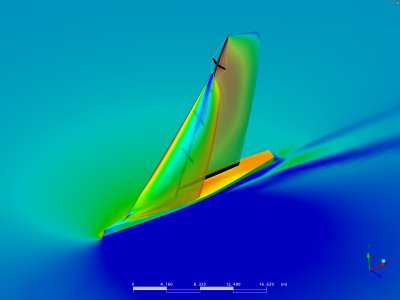
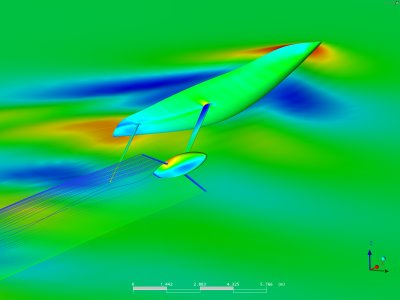
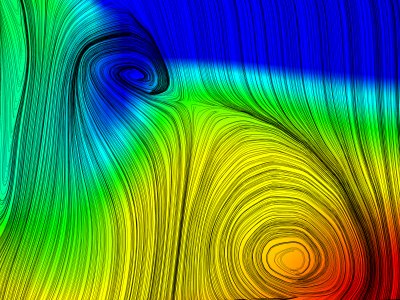
 Here is a basic explanation of how the sea breeze is created (with numbers in brackets refering to the numbers in the graph): At the surface, the sun warms both the ground and ocean at the same rate. However, since the heat in the ground is not absorbed well it returns it to warm the air. The warmed air, with its decreased density, begins to rise (1). The rising air creates a weak low pressure area (called a thermal low) due to a decrease in air mass at the surface (2). Typically, from 3,000 to 5,000 feet (1,000 to 1,500 meters) above this low pressure, as the air cools, it begins to collect resulting in an increase in pressure, creating a "high" (3).
Here is a basic explanation of how the sea breeze is created (with numbers in brackets refering to the numbers in the graph): At the surface, the sun warms both the ground and ocean at the same rate. However, since the heat in the ground is not absorbed well it returns it to warm the air. The warmed air, with its decreased density, begins to rise (1). The rising air creates a weak low pressure area (called a thermal low) due to a decrease in air mass at the surface (2). Typically, from 3,000 to 5,000 feet (1,000 to 1,500 meters) above this low pressure, as the air cools, it begins to collect resulting in an increase in pressure, creating a "high" (3).






